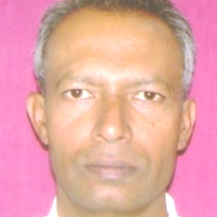
Rajankumar S. Bichkar
Work place: G.H. Raisoni College of Engineering and Management, Pune, India
E-mail: bichkar@yahoo.com
Website:
Research Interests: Data Structures and Algorithms, Algorithmic Efficiency, Analysis of Algorithms
Biography
Rajankumar S. Bichkar has completed his B. E. Electronics and M. E. Electronics from SGGS College of Engineering and Technology, Nanded (then affiliated to Marathwada University, Aurangabad) in 1986 and 1991 respectively. He has completed his Ph. D. from IIT, Kharagpur in 2000. He has worked as Lecturer, Asst. Prof. and Professor (till 2007) at SGGS Institute of Engineering and Technology, Vishnupuri, Nanded and is currently working as Professor (E&TC) and Dean (R&D) in GH Raisoni College of Engineering & Management, Pune since 2008. He has to his credit 3 books (on Basic and C Programming) and more than 30 papers in Conferences and Journals.
Author Articles
Optimization in Image Fusion Using Genetic Algorithm
By Jyoti S. Kulkarni Rajankumar S. Bichkar
DOI: https://doi.org/10.5815/ijigsp.2019.08.05, Pub. Date: 8 Aug. 2019
Day by day, the advancement in sensor technology is increasing which is used for image acquisition. Different sensors can acquire the information of different wavelength. These sensors are not able to capture the complete information from the scene. Thus it is necessary to combine the images from different sensors to produce more informative image. Image fusion is the process of combing the information from input images. According to the application or need, image fusion technique can be used. Number of techniques with varieties of solutions is available for image fusion process. And thus it becomes difficult task to find an optimal solution for image fusion. Genetic algorithm is an optimization technique used for searching solution for large number of complex problems [15]. This paper gives the quality index of image fusion obtained using the combinations of different selection methods and crossover techniques in genetic algorithm. These techniques have been compared using root mean square error to obtain information about relative performance. The experimental result on some standard test images shows that performance parameters i.e. root mean square error (RMSE) and peak signal to noise ratio (PSNR) are good for multifocus and multisensor image fusion.
[...] Read more.A Centralized Key Table based Communication Efficient Group Key Management Protocol
By Manisha Y. Joshi Rajankumar S. Bichkar
DOI: https://doi.org/10.5815/ijcnis.2015.08.06, Pub. Date: 8 Jul. 2015
Group key management is an integral part of secure multicast. Minimizing the number of rekeying messages, maintaining the forward and backward secrecy has always been a challenging task. Though there are many solutions which reduce the rekeying messages from Ο(n) to Ο(log_2?〖n),〗 they increase with the increase in group size. In this paper, we present a centralized key table based communication efficient group key management protocol in which number of rekeying messages is independent of the group size. In this protocol key management server (KMS) divides a group of n members into n subgroups of size n-1 and maintains a table of n subkeys along with member ID and one group key. Each member has n-1 subkeys, which is a subset of n subkeys of KMS and one group key. The proposed protocol requires only one multicast rekeying message per joining of a new member as well as per eviction of any existing member. As the number of rekeying messages is not dependent on group size, it requires less computation.
[...] Read more.Other Articles
Subscribe to receive issue release notifications and newsletters from MECS Press journals